My case for the lightweight English jacket
By Aleks Cvetkovic.
For much of my career I’ve felt like an anomaly, especially at the likes of Pitti or industry events. Principally this is because I’ve always chosen to wear structured tailoring, largely from London tailors, over the unstructured, Italian style that’s dominated menswear for the last 10 or 15 years.
Italianate tailoring is lighter, comfier and more casual than its British or French equivalents, or so the prevailing wisdom tells us. While unstructured tailoring is undoubtedly light and comfortable – and to be clear, I’m absolutely not disputing this – I’ve never bought into the notion that it’s the only solution for men who want to wear tailoring that feels natural on the body.
Perhaps it’s my innate pro-London bias, but I’ve always preferred to wear jackets with structured shoulders and firm, canvased chests. When I first got into tailoring, it was ‘olde worlde’ Hollywood glamour that drew me in, suits with ‘shape and drape’; it irks me that much of the menswear world discounts shapely, drape-cut tailoring as impractical and uncomfortable.
In order to illustrate my point, Simon has asked me to photograph a couple of outfits that demonstrate the principles of shape and drape, and why they work for me.
First up is one of my all-time favourite pieces, a jet black wool-and-cashmere double-breasted blazer from Edward Sexton, cut with a little extra volume in the chest compared to a conventional Sexton garment.
This jacket was cut for me by Sexton’s Cutter, Nina Penlington, and is her evolution of a pattern that Edward drafted a few years ago.
Back then, Edward used to create garments for me that he called ‘semi-drape’ in style, inspired by the prevailing cut he learned to draft in the ‘60s under the legendary Fred Stanbury at what was then called Kilgour, French & Stanbury. I don’t really remember how we came to the decision that the look was right for me, but somehow it clicked.
In this semi-drape style, the tailor creates a generous, roomy jacket that emphasises the shoulder, chest and hip without putting much suppression into the waist. It’s purposely cut with room to move, not close to the body.
It’s the style that prevails in a lot of 1930s fashion plates (above) – those illustrations we all love of square-jawed men with squarer shoulders, Herculean chests and only a little pinch through the waist.
It was also a style that Cary Grant gravitated towards in the early 40s. See how the jacket below combines built-up shoulders and broad lapels with a great big chest running into the sleeves?
Essentially, the garment is big and therefore comfortable, but also sharp because of its silhouette, which is more architectural than full-on drape coats from the likes of Anderson & Sheppard.
It’s tricky to capture the blazer’s subtleties thanks to its plain cloth, but the chest is by some way the roomiest I own, designed to complement an elongated, softly padded and roped shoulder line.
The lapels are generous, but not over the top, and the pocket flaps are a good 2.5 inches deep. Nina did a superb job balancing the blazer’s proportions, all round.
The large chest and shoulder add gravitas to the coat, which I like, but it doesn’t feel stiff. It’s big but not rigid. On the body it feels easy-going, almost slouchy.
It’s a different kind of softness to a Neapolitan or Florentine garment, and I think rather more glamorous. At the same time, it feels loucher and less ‘proper’ than garments from tailors like Huntsman or Chittleborough & Morgan.
A roomy coat like this also suits a full-cut trouser, but doesn’t feel like a period piece. These cavalry twill trousers are Saman Amel’s ‘Amo’ style, which has a contemporary rise and well-placed single reverse pleats – they’re a forward-looking style, not at all nostalgic.
The second look is firmly out of season, but I’ve dressed it how I wear it in summer, with an open-collar linen shirt and soft loafers (horsebits from Horatio).
It's a double-breasted suit from the ever-reliable team at Whitcomb & Shaftesbury, cut in a breezy wool, silk and linen plainweave from Solbiati. There is only the thinnest layer of canvas in the shoulders, creating minimal weight or bulk, and while it’s made without domette, the coat is canvassed through the lapel, chest and foreparts, for a lovely rich shape.
It’s a design that Suresh and Mahesh call their ‘Air Jacket’, which was first designed to wear in the heat of Chennai, home to Whitcomb’s tailoring workshop.
The jacket is almost entirely unlined, and unusually the sleeves are also unlined, bar a thin band of lining around the cuff. The result is a jacket with a dead-straight shoulder line and three-dimensional chest that is absolutely featherweight – impressively so.
It’s not quite as soft as an Italian jacket, but it’s every bit as light. And, in a professional or evening context in particular, I find this suit much more appropriate than something with no shape and slouchy shoulders. It’s neater and cleaner all round.
Incidentally (and I know I’ve made this point before) this suit is a great example of working patiently with a tailor over the long term. My pattern is so good from Whitcomb & Shaftesbury that every time I now slip on a new garment it’s staggeringly clean. We had to do almost nothing to this suit and the team did an excellent job of getting it ready for a warm-weather business trip in record time.
Another of the benefits of a roomier jacket is that its generosity gives you license to enjoy other styling details.
The gauntlet cuffs on this suit (a Whitcomb signature) would look odd on a Florentine jacket, for example – which is all about soft lines and curves, rather than confident shapes and angles – but they suit a jacket with a classical silhouette. The same applies to the lapels, with their breadth and horizontal peaks.
It’s purely personal preference, but I think garments like these are more flattering and more elegant than their unstructured cousins. They capture something of a bygone era but feel modern too. They disguise more sins, flatter more attributes and present an all-round sharper impression to the world.
There will always be a place for unstructured tailoring, and I expect it’ll remain the prevailing choice among stylish men but, for those of you who are feeling adventurous, or seeking something different, don’t write off a structured style. Seek out and experiment with tailors who celebrate the concept of ‘shape and drape’ and you might well be pleasantly surprised.


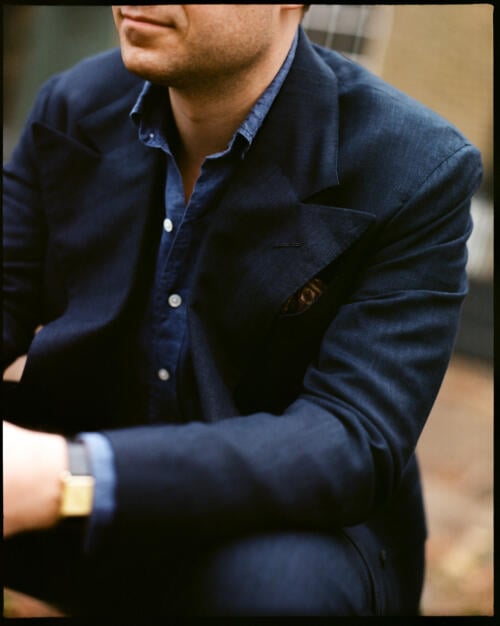
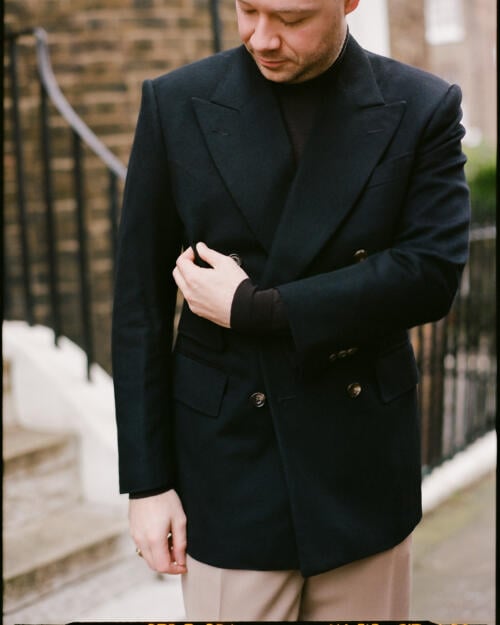
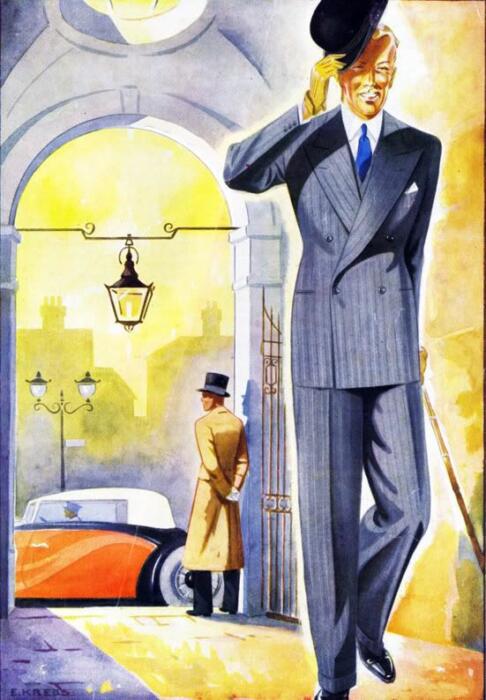
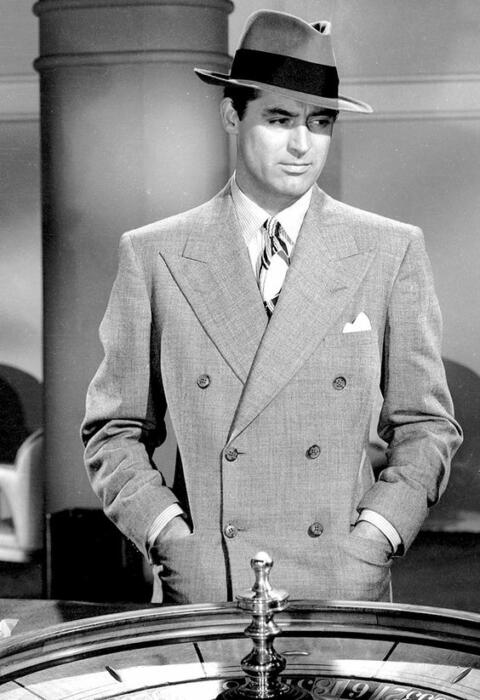
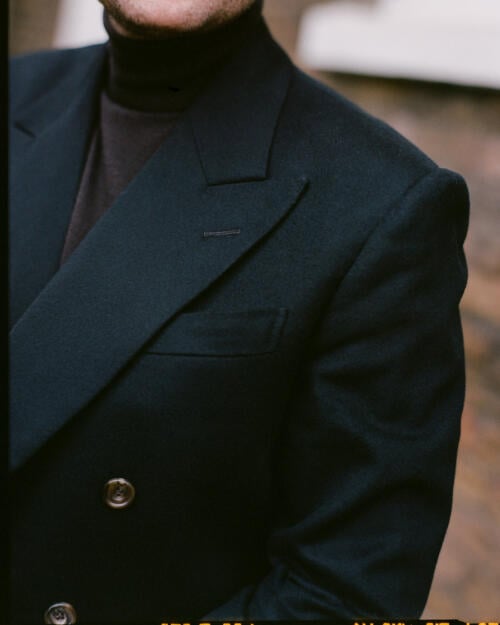

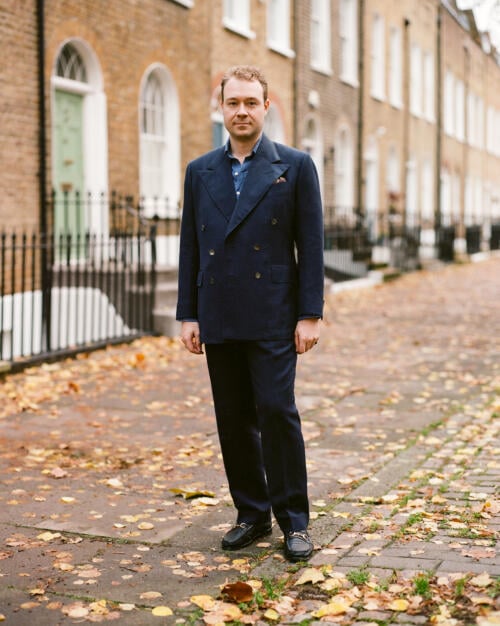
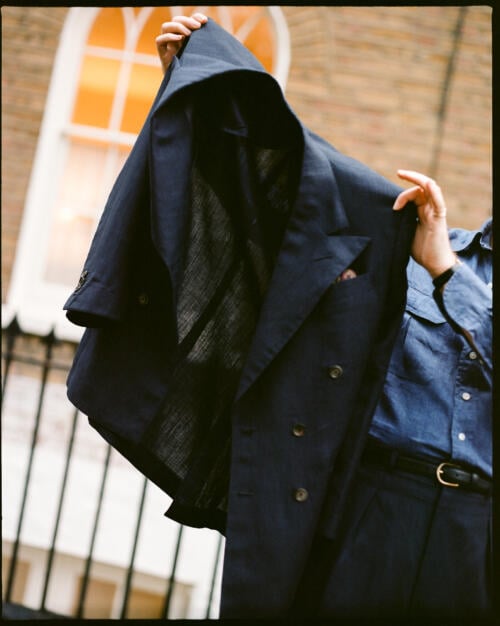
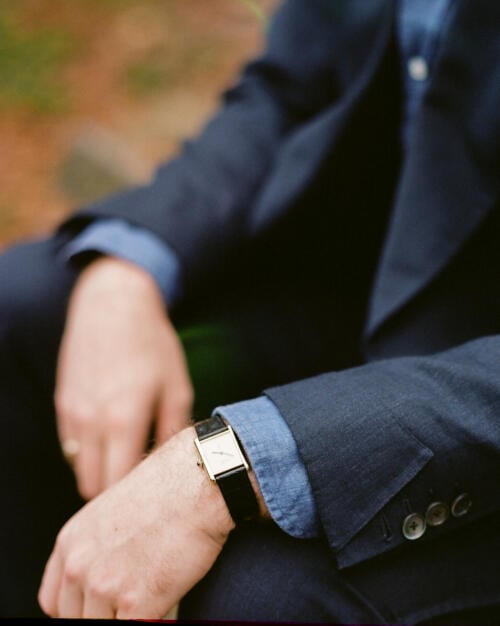
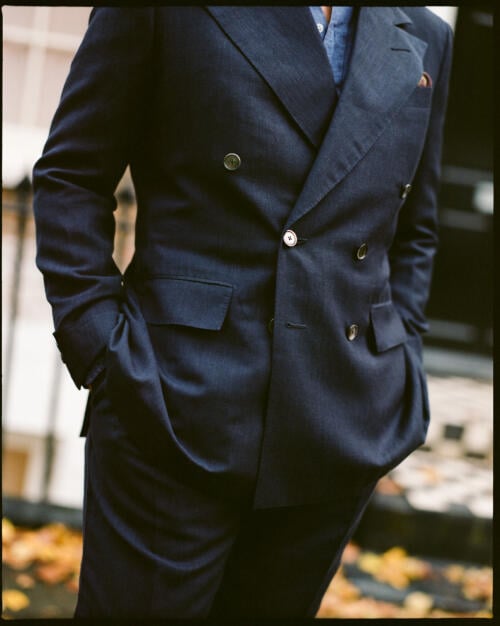


























This is a sublime and beautiful article on lightweight jackets as I’m looking for inspiration for a beautiful dark navy jacket.
Right up my alley with this post!
Thanks for reading, glad you enjoyed the piece!
Good to read about ‘structured tailoring’ given how much about the comfort of ‘unstructured tailoring’ (almost an oxymoron) is talked about .
I’ve been following AskOkey who seems to be a convert from Italian to full drape tailoring and the point you make about not wanting full drape to look like a period piece is very relevant to what he does.
P.S.
Alex’s, any thoughts on the AskOkey cut ?
Haven’t seen any independent reviews of his stuff but it seems to be very different from anything else out there and making quite a social media presence at least .
I also would like to see an independent and educated review of AskOkay. I like drape cuts, but I’m not a big fan of the way they do it. They do it more in the Hollywood tradition rather than the A&S way, but it doesn’t have the shape of the Hollywood drape cut either. I’m not quite sure what they’re going for.
I am a bit sceptical of remote fittings. I seem to remember that Simon has had some done without much issue, but I think those were guided, and this AskOkey website doesn’t make that clear as far as I can tell.
This is why I’m curious to see a real review of a suit and the process. The fit I’ve seen lacks the same attention to detail we see on Aleks’ jackets here. But are full cuts but very different. Alex has the drape that Okey speaks of, while Okey’s suits are more 1940s Zoot suit than drape suit.
plus his strange narcissistic behaviour on Styleforum has put me off rather
Me three! Love the AskOkay cut – sublime!
Hi Robin, thanks for reading – glad you enjoyed the piece.
To answer your question, AskOkey hasn’t really been on my radar, partially because I find the styling a little too ‘period’, personally. The jackets in this piece draw on the principles of drape-cut tailoring, but without replicating something from the 30s or 40s. I much prefer style that references the past but keeps one foot in present, if you see what I mean. I’d be interested to hear how you get on if you do try AskOkey.
Robin, AskOkey said in a single video that tweed couldn’t be made of lambswool (it can), that angora came from sheeps (it comes from the rabbit of the same name), that no single house on savile row has any “house style” and that they just “all purchase the same pattern from prada” (actual quote), that they’re all the same and don’t deisgn / do patrons at all, hard dissed italian tailoring, and the list doesn’t stop there. In a single video. Other videos are not better.
If so called experts can’t see the difference between Anderson & Sheppard, Huntsman and Prada nor do they know anything about fabric at all, how can you trust them to make you a reliable product? You do what you want with your money, but they ain’t getting mine for sure.
Blimey. That does not sound good
This article comes roughly at the same time that Suitsupply has introduced a new DB cut with defined shoulders, and from what I hear, also a looser waist, which is pretty much the opposite of the rest of the Suitsupply DB offering:
https://suitsupply.com/en-dk/men/suits/dark-grey-striped-milano-suit/P6842.html
I’m actually waiting for this one to show up in the local store so I can give it a try.
I was wondering if this means that structured suits are going to be “in fashion” again, what do you think?
Personally, Dario, I think they’ve been having a resurgence for several years now, particularly around tailoring as evening or party wear – for occasions.
However, I think the way trends work has changed – I’m not sure there will ever be the dominant fashions we had in the past, and so structured tailoring will never dominate as soft tailoring has done. The world and its media are too fast and fragmented.
Yes, it’s been there for a while and Suitsupply seems to catch up only after a few years with the #menswear sphere. It’s not so long ago that they started offering higher waisted, pleated trousers with a wider legline. I was wondering if this will eventually be seen in high street shops like Hugo Boss for example.
Hi Dario. I agree with Simon here, I think parts of the tailoring landscape have gently moved towards a more generous cut over the past three or four years – particularly in high-fashion, where the ‘oversized’ look has been in vogue post-Covid. It always takes time, but I think you’re absolutely right that this will trickle down to the high street eventually.
Thanks for sharing Aleks – very interesting piece, and I really appreciate the intention to get the best of seemingly contrasting styles.
You’re spot on with the fractured media landscape Simon – working in film where there once was a range of in-vogue styles of shooting \ treating moving images, there is far more diversity in the visual point of views presenting in mainstream media and that is only likely to continue to diversify.
That said in a world of infinite choice it’s curation by respected voices that can really move the needle – we’ve seen that in publishing where there are many thousands more times the books available to read now than say 20 years ago but majority of sales remain focused on a narrow range of hot and popular titles, and reviews and bestseller lists (and social media popularity) guide consumer choices more than ever – I’m sure you’ve both seen similar trends in tailoring.
With that fractured cultural landscape, and the descending cost of high-street clothing, more and more people can afford to have their wardrobe be their personal avatar – represent more precisely the image of themselves they want to present to the world – the more we see parallel styles available at the same time, and the more we’ll see lower cost options for customizable clothing.
And while that end of the market isn’t the area of focus here, the influence of classic bespoke tailoring is certainly present in the ever growing lower cost (and often exclusively online) semi-custom services now available, and writing like this absolutely raises the tailoring-literacy level of interested consumers who will try these services.
It may seem rather far fetched, but we are likely not far away from AI tailors who can scan your body from a smart phone, allow you to choose and see yourself in various clothing options, and then manufacture one-off garments to your precise measurements, to your exact taste, and to a high degree of quality and accuracy ~ it will be the cubic zirconia to bespoke tailoring’s diamonds, but even in that world thoughtful writing about tailoring will be influential 😉
Thanks Zac. I remain sceptical on the last point though – you’d need to scan the customer’s brain as well, because people want things to fit very differently to each other, and much of the beauty of bespoke is the interaction between maker and customer. Of course, the computer also wouldn’t bother to do the craft side of bespoke. At the most this could become a designer-brand MTM, when you want only their design, how the brand would make it to your specs
Really interesting on the media points, thank you
I couldn’t agree more with you about the personal experience and maker – customer relationship.
To clarify, I don’t think the scan-to-dressed-man service is one that most readers here would been keen on, but I think there would be a market for that kind of service, aimed at those without deep interest, or deep pockets : )
The first look is epic! Also nice to see an article on more structured tailoring
Thanks, Nick. Appreciate you taking the time to read the story!
Love the Whitcomb one. Do you remember price?
Hi Alfie, glad you like it – it’s a clever piece of design, and as always, beautifully made. From memory, around £3k.
Really enjoyable article and I like your argument and also tend to dislike unstructured jackets. The only thing I’d add is lightweight I associate with summer – I’d be more tempted to go with lighter colours?
Hi JR, thank you for reading – much appreciated. I find navy, particularly a relatively light navy, like this, perfect for my professional wardrobe in the summer. I’d love wear cream and beige linen suits, but I don’t think they’d give clients the right impression, sadly!
The lapels on the W and S jacket are exquisite. Interesting read, I’m all in on Italian-style tailoring at this stage and happy with how it looks. Perhaps this is due to my already quite angular, boney, neck and shoulders which I feel look worse with structured shoulders. However Aleks wears his style so very well and it’s always a pleasure to see pics.
Thanks, Fred, kind of you to say. And you’re absolutely right, a structured look like this won’t suit everyone. Shoulder-shape and physique absolutely do play their part.
A different but worthy take indeed. I also find my Neapolitan-style sportscoats with their unstructured shoulders and lapels a bit too casual for informal business meetings. Alex’s lightweight suit jacket from Whitcomb & Shaftesbury seems to be a good option to consider.
This article made me recall and search Simon’s feature on the lightweight Dege & Skinner jacket, available here at https://www.permanentstyle.com/2022/06/dege-skinner-lightweight-summer-jacket-review.html
As opposed to W&S where a semblance of structure is kept on the chest and lapels, and does away with it on the shoulders, Dege approaches it the other way around, keeping a wee bit of the structure on the shoulders but ditching it altogether on the chest and lapels.
I haven’t had the fortune of trying both W&S and Dege to compare which works better for informal business meetings. I do have a made-to-measure from Trunk Clothiers which was intended to be soft and lightweight, with light canvassing on the chest and shoulders, and I ended up having the light padding on the shoulders removed. It looks much better for that, and still apt for business meetings.
I wonder if others have their own take.
Interesting to hear, Julian. I have found it’s taken a few different tailors to find a lightweight ‘semi-structured’ garment that I’ve been happy with. Not easy to find, but worth persevering for!
No offense meant, and of course my personal subjective view, I think this style looks anachronistic.
Firstly, padded shoulders don’t look good to me. They look too broad, like you’re wearing a jacket that’s too big. Also, there’s a bulge at the shoulder that doesn’t blend into the arm and therefore looks like sloppy work (which of course it isn’t).
Secondly, while the slim fit has gone too far, the shape of the jacket looks bulky and makes you look bigger than you are. I think most men want to avoid that. But even if you are very slim, you would look lost in such a large jacket.
Thirdly, at the moment it seems questionable whether the separate jacket will stay at all. I’ve often heard well-dressed men in their mid-40s (my age and the age of most of my friends and acquaintances) say that it’s a look for old men (interestingly, this doesn’t apply to suits, which will probably be common in formal settings – court proceedings, conferences – for a long time to come). This applies less to casual unstructured jackets (I am a big fan of Boglioli‘s K-jackets), but even they start to look old fashioned.
I have to say, these were pretty much my exact thoughts after reading the article. The jacket might be excellent quality-wise, but it looks like something you might find at a vintage clothing shop for 50 bucks. The cut just makes it look like it was made for somebody else entirely, and the shape of the lapels looks rather out of date.
And contrary to what a lot of “10 essential clothing items for men”-lists might say, I think a blue blazer isn’t versatile at all. What can you wear it with? Beige chinos and grey wollen trousers, that’s it. And both combinations look both tired and decidedly ‘old-man’ to me. It might work with washed denim, but only if it’s an unstructured jacket, which this one isn’t.
Suits will (thankfully) always be around, but as far as sport coats go, I’ve sold most of mine off and only kept the ones that go with denim and suede shoes (mostly dark brown/olive/greige Boglioli and Windsor jackets).
Well, just pair a blazer with olive coloured trousers. Or a nice shade of medium brown. On a summer’s day with a lighter blue or sand or a lighter grey. On a promenade perhaps with a dark yellow or if you dare with salmon coloured trousers. Plenty of choices! It all depends on the context, the weather, the texture of the cloth too and your own mood 🙂 The thing here is that once you have a tailor made blazer you can pair it with so much because of that navy colour on your torso. Yes, grey and beige trousers compliment it well. They are a safe, but certainly not the only choice. Safe, because they already give you a wonderful platform to experiment with a multitude of looks. E.g. a green/white striped bengal shirt, a coloured polo shirt… just use your imagination.
I think what makes a navy blazer-or even more so a navy jacket without metal buttons-so very versatile is NOT the variety or trousers you can wear it with, but the amount of settings you can wear it in. Outside of a rock concert or black tie event you can wear a navy jacket almost anywhere. Forty years ago you could say the same thing about a grey suit, but that isn’t true anymore.
If everyone else is in a suit, you won’t look out of place while you would in knitwear or shirtsleeves. When everyone else is in knitwear and shirtsleeves, a blazer won’t look out of place while a suit would. Dinner? Work event? A fancy garden party but you’ve no linen tailoring? Horse races but you’ve no tweed? Even a hot day when everyone else is in polo shirts you can get away with a lightweight navy jacket.
It is the perfect choice when you don’t know what other people will be wearing- if it does turn out too fancy for the crowd pretend it’s your outerwear, and hang it with the coats.
Funny that you can ask whether or not the look will remain, given the enormous menswear resurgence occurring now. Just take a look at any brand selling menswear to ask whether or not their are still sports jackets being bought and worn.
Jackson is on the money. It’s all about the styling. The odd jacket will remain in civilian life for longer then the longue suit, since suits are now thought of as more ceremonial. Separates with sneakers (questionable from a sartorial stand point) will remain for the rest of this century with all likelihood
Absolutely agree, Ivan.
Hi Markus, thanks for this.
There’s certainly an old-school charm to these jackets, and that’s a big part of the reason why they appeal to me. Semi-drape tailoring isn’t going to be for everyone, but the article is there to encourage curious parties to explore the genre. I don’t agree that these are ‘bulky’. Perhaps the camera doesn’t do them justice, but the purpose of a semi-drape jacket is to lend stature to your figure, not swallow it or detract from it.
I don’t see odd jackets going anywhere, any time soon. Every brand under the sun, from independent tailors to high fashion labels, makes them year-in, year-out for a reason.
I never understood the claim that structured tailoring, at least high-end structured tailoring, would be uncomfortable. The structure should work WITH your body, not against it.
Unstructured tailoring looks amazing if you’re fit, but as a post-pandemic desk warrior, I’m grateful for a little help to accentuate my shoulders.
Thanks, Sams. Quite agree. The structure has to flatter, not fight the figure. Not something tailors always get right, but if you can work with a tailor who does get it right, then it’s a beautiful thing.
While the choice between a more structured English suit and its softer Italian equivalent is framed here as a matter of aesthetics (which it certainly is), I’m curious as to how body shape may factor in, too. I’ve never liked roped, built-up shoulders on myself personally, because I have very high and broad shoulders and begin to look like an NFL player with any padding. Conversely, I have a good friend with sloped shoulders who is complemented very well by the roped and padded jackets he prefers.
Structured English does not require roped shoulders, and broad shoulders is not the converse of sloped shoulders. (Most bodybuilders have both a broad and sloped silhouette, the latter due to large upper traps.) A good English tailor can certainly make a good structured suit for a muscular guy. A recent example that comes to mind is Henry Poole’s stuff for Jason Momoa.
Hi Eric, a very good point and perhaps something to address in a future article. Structured tailoring isn’t for everyone, but it certainly can help to flatter with sloped or slightly less square shoulders.
Hi Eric, I think in a way that’s the point Aleks is making here – taking aspects of various tailoring styles and traditions to better suit your taste and your body.
I’m also very broad shouldered and a jacket too much padding in the shoulders, and too little pinch in the waist, tends to have me looking like a well upholstered refrigerator. For myself I find that double breasted jackets, with a low buttoning point, and broad lapels, but with soft shoulders and a good pinch, tend to suit my frame well – but those can be difficult to find off the rack.
At various price points, I’ve had good results with Spier and McKay customs and off the rack, with some jackets from New and Lingwood (example links below), even a reasonably successful jacket from Albert clothing (happenstance their default cut work well for me, but their construction isn’t great, and their customer service and delivery times was so atrocious I cannot recommend them – items that appear as in-stock have in fact not yet been manufactured and a suit ordered in November as off-the-rack arrives in January. Had to DM their instagram account to get anyone to reply to emails and they flat out do not accept returns – just appalling).
Living away from a major centre of tailoring makes trying out options time consuming and sometimes costly, but if you’re going to roll the dice Spier and McKay are the safest option : )
https://www.spierandmackay.com/product/navy-linen-double-breast-sportcoat-ss23
https://www.newandlingwood.com/mens-clothes/occasion-wear-for-men/dark-green-double-breasted-velvet-jacket-1722741-800
https://albertclothing.com/collections/jackets-1/products/ascot-blazer-navy
I can only speak of my own context but I rarely see anyone wearing a suit or sports coat in in my business sector or my friend groups.The only time when dressing up is called for is for events such as weddings. And when the event calls for it, people are usually eager to dress up. In that context why not opt for something with a bit more personality? The soft tailored look is so ubiquitous when you look at tailoring in stores that the structured stuff feels more exiting. At least to someone who was too young to wear suits back when structrure and full cuts was the norm. To me my slim navy Saman Amel suit makes me feel more like a banker than a loose fitting, strongly structured 2000s grey pinstripe from Zegna that probably used to belong to a banker 😛
Love these examples by Aleks, especially the first look. Very chic.
Thank you, Simon. And you’re absolutely right, the business suit is increasingly becoming an endangered species. One of the benefits of both the jackets / suits in this article is that I often dress them up for events; dinners, date nights, parties, etc.
Really love Alek’s style. Simon, would any of the South Korean tailors you’ve looked at recently be able to cut a jacket in a similiar fashion?
Hey Luke. The closest would be Tranquil House, as he trained in the UK, but I’m not sure how structured he would be – perhaps similar to Whitcomb, not as much as Sexton
I can’t say why, exactly, but I’ve always preferred the structured style to the less structured one. Both are beautiful, though. It’s impossible to say I like one and don’t like the other.
Thanks, Jack. Variety, as they say, is the spice of life.
I agree that Nina Penlington is a superb cutter. She cut a wonderful suit jacket for me in the classic Sexton/NSR style. Strong shoulders, heroic leafy lapels, balanced with deep pocket flaps. Structured and architectural, but very comfortable. I too prefer the athletic, masculine silhouette, and the elegance the structured jackets from Sexton provides
Nice, Sean! Sounds like textbook Sexton to me.
I appreciate this article as this has been my favourite style of tailoring. Lightweight with structure. It’s not often talked about when people usually focus on the more well-known military and drape Savile Row styles. This sounds like what Italian tailoring often used to be before everything went the softer way it is today. I have a Canali blazer that’s 16 years old, and it’s soft and lightweight but very shaped. The shoulders are too big for my taste, but the concept is the same. I prefer the English approach to it.
Thanks, Matt. Like the sound of that Canali number!
Totally get your point and well stated.
hi
Beautiful looking jackets.
i have never understood the difference between padding and wadding.
I mentioned once at A and S that the jacket they made for me seemed padded as the shoulder extended just beyond the anatomical shoulder and the shoulder felt bulky. I was told it certainly was not padding and that the A and S shoulder is the lightest. Personally the bigger shoulder suits me even as a short man, something people may not expect
Structured tailing can be quite comfortable, but it has to fit correctly! A structured jacket (or even heavy overcoat) can feel surprisingly light and mobile when the fit has been nailed. Unstructured jackets are a bit more forgiving in this regards – even if the fit is a bit off, they can still feel quite comfortable.
I’ve been wondering where you’d been, Aleks!
Good to see apiece from you. I agree with almost everything you’ve written in this article. I haven’t had anything cut by Nina, yet, but the two jackets I have that Edward cut feel very similar to me to what you describe as the qualities of your jacket. Structured, with an unmistakable silhouette, and very comfortable to wear. My preference has always been and remains for that structured shoulder, sharp silhouette. From time to time I think to myself that I should try an Italian tailor, but I always seem to talk myself out of it.
I have what may be an odd/outside-of-scope question. I’m mid-forties and recently went through a significant career change. I’m an accountant by trade and spent the last fifteen years as a n executive working in oil and gas. I knew how to dress then.
A couple of years ago I decided that I’d rather do my own thing and after getting my ducks in a row, I gave up my day job. For the last year, I’ve been a small business owner-operator. It’s been a great change, but I am starting to feel a little scrubby. My days are pretty varied, I’ll go where I’m needed. Sometimes that’s sweeping the floor, sometimes it’s schlepping boxes in the warehouse, sometimes it’s talking with a customer, sometimes it’s sitting in a meeting. My default has become some decent boots, usually rough out, a pair of jeans, and a t shirt with a tailored flannel overshirt (it’s cold in Canada) or a sweater.
I’m not particularly imaginative and so I’m wondering if I’m missing something. Are there some other options I should be considering? I’d love to see an article or two on light work-wear, or clothes that are versatile enough to sometimes unload a truck or pack a box (i.e. smart outfits that could handle getting a little dusty once in a while).
Thanks Nicholas, I like the idea and there are certainly possibilities. Eg slimmer more elegant boots from still tough materials (eg cordovan), lambswool sweaters (eg Rubato) and perhaps a nice jacket that can be taken off when manual labour is required.
Nicholas, also see our piece on weekend clothing, which contains references to a lot of the workwear we have covered.
Thanks so much for this. It’s very helpful. I’ll take a closer look at cordovan boots. I’ve been wearing the roughout because it’s pretty easy to manage scuffs on. With all the snow we get here I’ve been pretty relucant to get any kind of shell boots, the snow inevitably turns to water and leaves all kinds of discoloration, at least in winter.
Hey Nicholas,
Shell should be pretty water-resistant, if you look after it. Also that kind of suede from makers of slimmer boots, eg an English one like Crocketts or Edward Green. Will look smarter and can be oiled/waxed a lot to make them waterproof
To each its own… But this look is not for me. The jacket looks boxy despite you being slim – it’s not even that it’s unflattering, just looks like taken from bigger brother. Second point is that I personally think DB jackets are generally more formal. Blending them into casual look, appears off to me and too contrasting vs trousers.
Thanks Kuba, it’s all personal preference, as they say. I tend to wear more double-breasted jackets casually than I do single-breasteds. I like to play with conventions slightly, and a ‘formal’ cut worn casually can be very interesting.
For most men, a good structured jacket is more flattering to me than a good unstructured jacket. If the art of bespoke is about creating the most beautiful silhouette on a given body—and I submit that it is—then structured is the way to go.
But if you’re going to wear a structured jacket, embrace the structure. Fasten those buttons. That full-body shot of the W&S looks terrible and doesn’t do any justice to the skill of its makers. (Hosebit loafers definitely not the way to go there either.)
Milanese style middle ground
Good point. Never tried a Milanese tailor, but if I wanted an Italian suit, I’d go to Milan. Always liked the look of Musella Dembech.
A nice read!
Though I am fond of my structured jackets, I can’t help but lean into the unstructured ones for my 4 most recent commissions.
I reason that since I am so fond of weightlifting, I have the muscle/frame to “Fill it in”.
That has resulted in me being slightly shy in my constructed pieces as of late. This article has awoken my appetite to wear some full canvas tailoring again.
Cheers!
That Sexton jacket and overall look is brilliant! I would love more articles from you Aleks.
Hi Aleks,
What.a great relief upon reading your post! I hope many readers would find it very useful when pondering how to inject at least a bit of sharpness into their wardrobe.
John
Your advocacy for structured tailoring amid the dominance of Italian unstructured styles is both refreshing and insightful. Your personal experiences and detailed examples effectively challenge the prevailing norms in menswear, offering readers a compelling case for embracing ‘shape and drape’ in tailoring.
i am afraid i like the DB with casual approach, eg, OCBD , casual loafers, chinos. it has always struck me as stylish for no reason than gut feeling .
This is a nice discussion. Personally I do not wear my structured jackets casually, I much prefer unstructured jackets with jeans and chinos, and pictures here tend to reinforce my views. I find it much easier to dress up an unstructured jacket than the opposite. But I am fortunate enough to work in an environment in which wearing a tie remains acceptable (even if we are becoming a minority…) and I must confess that I have never been more happy to wear ties since it puts you on the anti-conformist side…
Nice Eric, pleased to hear it
Does anyone have any experience with Blugiallo or with their Traveler Midnight Blue Hopsack suit that is made of a high twist fabric from Loro Piana? I am looking for a navy jacket for the Spring and Summer, and I live in the US South so lightness and breathability are paramount. I am new to the work force and so have some budget constraints.
I really appreciate the articles and site, Simon.
Cheers TJ. I don’t myself I’m afraid
Simon and Aleks,
i wonder whether i can ask a shoulder question here
when i look at the old films and TV serials of the 40’s, 50’s and even 60’s the eyes are always drawn to the shoulders of the men’s jackets .
the top seam always seems to run backwards towards the back of sleeve.
the modern makers seem to have forgotten this . I assume the seam running straight laterally is a modern construction . I know A and S do it the old way but still in a subtle way.
Just how did this change come about? Seems radical to me.
It’s something tailors would mildly disagree about, as to how beneficial it is practically, whether it looks worse aesthetically. But it certainly used to be more prevalent – of nothing else, far more people were wearing bespoke, and it is a hardee thing to do non-bespoke
That W&S is astonishing. A marvel. These smart cuts, though so suited to the writer, are alas so unflattering to so many, especially the beanpoles among us.
The unstructured Italian style of jacket means that they are not as long lasting and they “droop” quicker meaning they do not look as flattering as the structured styles in the longer term. The prices for the unstructured are often quite astronomical – albeit that they are often include expensive cloth like mohair, cashmere silk and linen eg Brunello Cucinelli, Isaia, Kiton and Brioni amongst others. In the age where sustainability is the buzzword I wonder how long the unstructured look will prevail.
Just to be clear Andie, I don’t think that applies really to bespoke tailoring, from softer Italian makers, and it’s very dependent on the material as well. A lot of those brands are RTW, no structure inside at all, and very lightweight, soft fabrics
Fantastic article and I couldn’t agree more about structured tailoring. Simon, do you know where Aleks’ belt worn with the Whitcomb & Shaftesbury suit is from?
No, but I can ask
Thank you!
It’s from Saman Amel
Thanks so much! Very much regretting hesitating and not buying it when it was released, the same goes for Rubato’s black alligator belt, as neither brand have restocked these items
Hi simon curious with the increase usage of ai world wide do you see yourself using these tools in your writing/reporting?
I can’t think of any reason to, to be honest Shem. It seems like the opposite of the personal and distinctive writing the site is known for.
I don’t know all the ways it can be used though, so if you know of anything interesting please do let me know.
I do Simon (i run AI stuff for education). But i wouldn’t advise anything at this stage. you can do predictive analytic stuff perhaps on comments to see who people like/sentiments, but please don’t use it for writing!
Thanks Paul. Yes I can see that would work for comments at a bigger scale, or if I weren’t going through each one personally